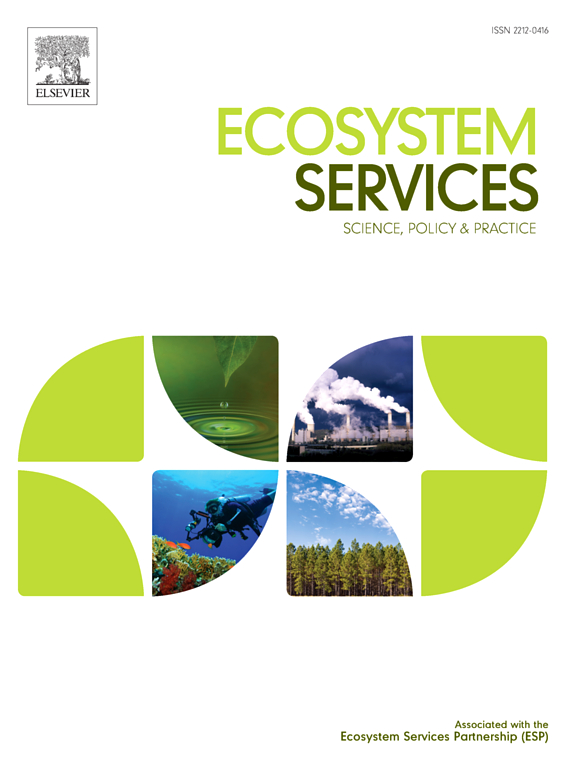祁连山生态系统服务及其溢出效应评估:为成本效益分享和横向生态补偿机制提供信息
IF 6.6
2区 环境科学与生态学
Q1 ECOLOGY
引用次数: 0
摘要
横向生态补偿在减轻政府财政负担、有效解决正外部性和生态系统服务溢出效应、促进上下游社区和谐关系等方面具有纵向生态补偿的诸多优势。然而,缺乏可靠的数据仍然是实施该计划的一个重大障碍。本研究采用InVEST模型、CASA模型、RWEQ模型及相关统计方法。此外,利用断点模型和场强理论对祁连山及其周边地区8种关键生态系统服务功能及其在不同空间尺度上的溢出效应进行了评估,旨在为祁连山及其周边地区的成本效益分享和HEC机制提供信息。结果表明:(1)土壤保持对生态系统服务的贡献最大,占47.26%,其次是保水(17.52%)和固碳(15.62%)。(2)森林(48.51%)和草地(39.22%)是提供这些服务的主要生态系统类型。(3)生态系统服务具有显著的内部耦合、外围耦合和远程耦合,在流域、省乃至全球尺度上产生溢出效应。(4)从外溢效应的范围来看,旅游休闲的外溢效应最大,其次是防沙、物资生产、保水、保土、防洪、固碳和授粉服务。根据这些数据,我们还构建了三条高输商路径:省内流域、省间高输商和国际高输商。我们的研究结果有助于建立一个公平和运作良好的HEC机制,提供多种环境和社会效益,有助于实现几个联合国可持续发展目标(SGDs),如消除贫困(#1)、零饥饿(#2)、气候行动(#13)和陆地生命(#15)。本文章由计算机程序翻译,如有差异,请以英文原文为准。

Assessing ecosystem services and their spillover effects to inform cost-benefit sharing and horizontal eco-compensation mechanisms in the Qilian Mountains, China
Horizontal ecological compensation (HEC) offers many advantages over vertical ecological compensation by reducing government financial burdens, effectively addressing positive externalities and ecosystem service spillover effects, and fostering harmonious relations between upstream and downstream communities. However, a lack of reliable data remains a significant obstacle to its implementation. This study employs the InVEST model, the CASA model, the RWEQ model, and related statistical methods. Additionally, the Breaking Point Model and Field Strength Theory are used to assess eight key ecosystem services and their spillover effects at different spatial scales, with the aim of informing cost-benefit sharing and HEC mechanisms in and around the Qilian Mountains, China. Our results suggest that: (1) Soil conservation contributes the most to ecosystem services, accounting for 47.26%, followed by water retention (17.52%) and carbon sequestration (15.62%). (2) Forests (48.51%) and grasslands (39.22%) are the primary ecosystem types providing these services. (3) The ecosystem services exhibit significant internal coupling, peripheral coupling, and tele-coupling, creating spillovers at watershed, provincial, and even global scales. (4) In terms of the scope of the spillover effect, tourism and leisure lead, followed by sandstorm prevention, material production, water retention, soil conservation, flood regulation, carbon sequestration, and pollination services. From these data, we also constructed three HEC pathways: intra-provincial watersheds, inter-provincial HEC, and international HEC. Our findings are useful for developing a fair and well-functioning HEC mechanism that offers multiple environmental and social benefits, contributing to the realization of several UN Sustainable Development Goals (SGDs) such as eliminating poverty (#1), zero hunger (#2), climate action (#13), and life on land (#15).
求助全文
通过发布文献求助,成功后即可免费获取论文全文。
去求助
来源期刊

Ecosystem Services
ECOLOGYENVIRONMENTAL SCIENCES&-ENVIRONMENTAL SCIENCES
CiteScore
14.90
自引率
7.90%
发文量
109
期刊介绍:
Ecosystem Services is an international, interdisciplinary journal that is associated with the Ecosystem Services Partnership (ESP). The journal is dedicated to exploring the science, policy, and practice related to ecosystem services, which are the various ways in which ecosystems contribute to human well-being, both directly and indirectly.
Ecosystem Services contributes to the broader goal of ensuring that the benefits of ecosystems are recognized, valued, and sustainably managed for the well-being of current and future generations. The journal serves as a platform for scholars, practitioners, policymakers, and other stakeholders to share their findings and insights, fostering collaboration and innovation in the field of ecosystem services.
 求助内容:
求助内容: 应助结果提醒方式:
应助结果提醒方式:


